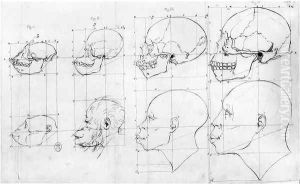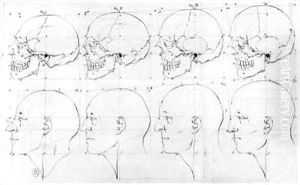Petrus Camper Paintings
Petrus Camper was a Dutch physician, anatomist, physiologist, midwife, zoologist, anthropologist, paleontologist, and a naturalist, renowned for his work in comparative anatomy, a field crucial to the development of evolutionary theory. Born on May 11, 1722, in Leiden, Netherlands, Camper was not only a key figure in the Dutch Enlightenment but also a prominent thinker whose interests and influence spanned across various disciplines of science and art. He is often remembered for his contributions to the study of human and animal anatomy and for developing the 'facial angle'—a measure he invented to determine intelligence among different species, including humans, which, though now discredited and considered racist, was influential in the 18th and 19th centuries.
Camper's education was comprehensive and included studies at the University of Leiden and the University of Harderwijk, where he obtained his degree in medicine. His academic journey did not stop there; he traveled extensively through England and France, engaging with eminent scientists and intellectuals of his time, which greatly enriched his understanding and perspective in natural sciences. Throughout his career, Camper was involved in teaching and held several academic positions, including professorships at the University of Franeker, the University of Amsterdam, and finally, the University of Groningen, where he extensively worked on anatomy and published numerous influential papers on the subject.
Apart from his scientific endeavors, Camper was deeply interested in art and was a talented illustrator, often drawing his anatomical observations, which were both scientifically valuable and artistically commendable. His interdisciplinary approach—merging art with science—enabled him to make significant contributions to orthopedics, cranial studies, and even the design of prosthetics. His work on 'facial angles' was initially intended to compare different animals and to study the differences between species, but it was later applied to racial and ethnic classifications in humans, a use of his work he himself might not have fully anticipated or endorsed.
Petrus Camper's legacy is a complex one, reflecting the breadth of his interests and the impact of his work across different fields. Despite the controversy surrounding some of his theories, particularly regarding race, his contributions to anatomy and science are undeniable. He passed away on April 7, 1789, in The Hague, Netherlands. Today, Camper is remembered for his scientific curiosity, his methodological innovations, and his ability to cross the boundaries between science and art, making him a quintessential figure of the Enlightenment era.

